The Arab Spring Protests
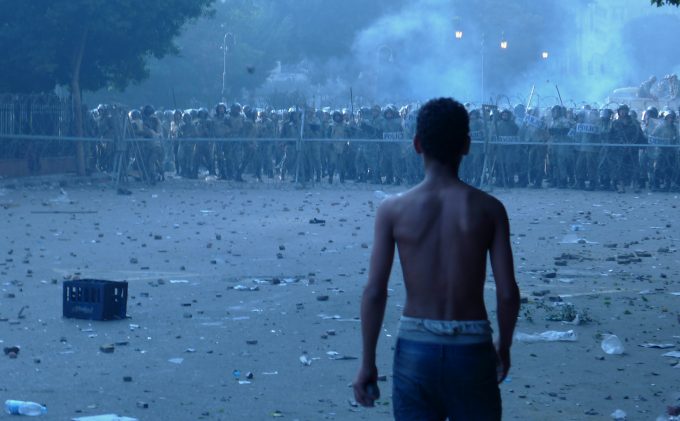
Ten years after shaking an entire world region, the protests of the Arab Spring of 2011 continue to preoccupy social scientists who rely mostly on documents and interviews to study them. Employing a different approach, we examined over 3,500 photos of the early phase of the protests in Tunisia, Egypt and Libya, to capture the meanings that protestors brought to the fore. We studied them the way that we would have studied text. We considered publicly available photographs of protests showing posters, props, drawings, banners, leaflets, T-shirts, and other ephemera.
We focused on frames and messages that protestors used to convey anger, despair, and also hope for the future. While injustice is a common master frame of protest in the study of social movements around the world, our findings showed that, with remarkable consensus in demanding an end to authoritarian regimes in Tunisia, Egypt, and Libya, protestors centered their protests on what we call a master frame of “reclamation.” Protestors reclaimed what they felt was their right to have and that dictators either never delivered or took away from them. In all three countries, protestors used the following three frames that together constitute the reclamation master frame.
1. evil, corrupt dictators and reclamation of decency in governance:
Depicting the authoritarian leadership in power as corrupt, oppressive and evil, protestors mobilized grotesque drawings and de-faced photographs of the leaders (photo 2). Vampires, devils, and snakes (photo 3) were common portrayals along with caricatures, as we observe in a depiction of Libya’s Moammar Gaddafi (photo 1). Gaddafi emerges out of a shoe, which is a symbol of dirt and degradation in North Africa. By referring to Gaddafi as “leader of the rats,” the sign directly maligns Gaddafi himself as a rat and echoes Gaddafi’s frequent reference to political opponents as vermin and dogs in decades prior to the uprisings.
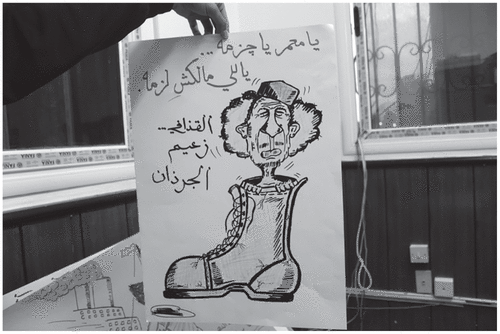
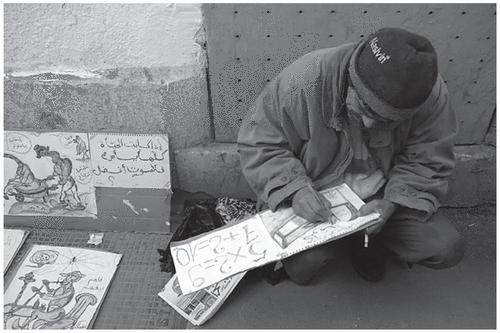
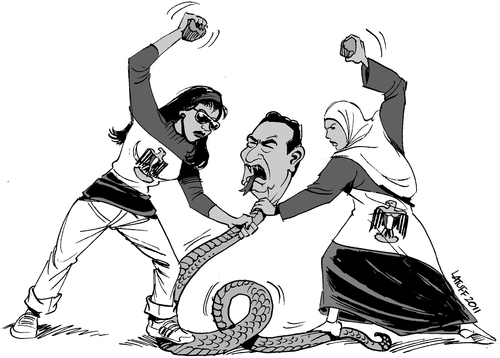
2. state violence and reclamation of justice and dignity for loved ones:
State violence in the form of unlawful arrests, harassment, disappearance and assassinations of political opponents was commonplace under the authoritarian regimes of all three North African countries. The self-immolation of Muhammad Bouazizi, a street vendor, who suffered repeated harassment and attempted extortion by municipal officials in Sidi Bouzid, a remote small town in rural Tunisia, triggered the Arab Spring protests in December 2010. Following his death in a Tunisian hospital, protestors mobilized Bouazizi as a hero, as is conveyed in the artistic rendering of his person surrounded by flames, symbolizing both his sacrifice and how his actions ignited a revolution (photo 4). Just as Bouazizi was venerated, protestors deemed victims of state violence (photos 5 and 6) as martyrs in Tunisia, Egypt, and Libya. Protestors reclaimed the dignity of those who were killed or disappeared by the brutal states. They demanded that justice be restored in identifying victims of state violence as fighters for justice and martyrs to be revered.
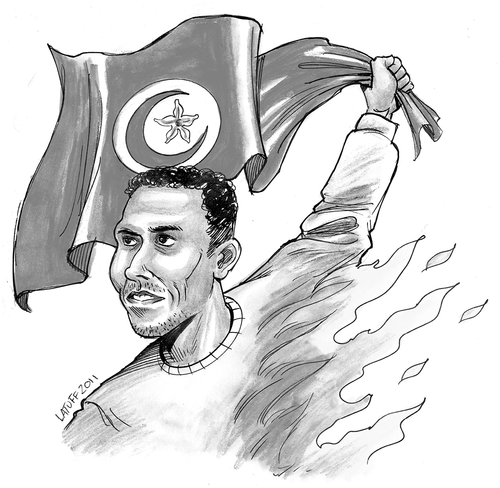
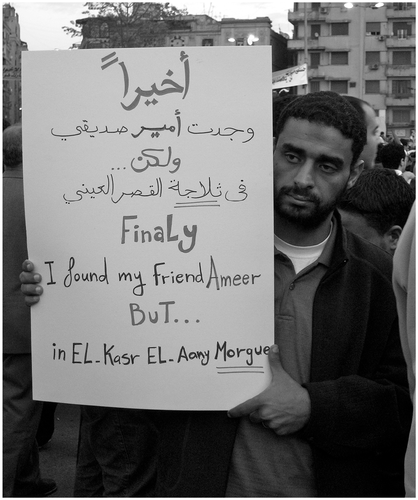
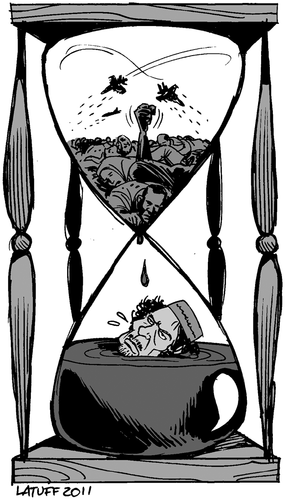
3. solidarity under the flag and reclamation of the nation for the people:
Protestors expressed their solidarity with each other, their love for the nation and their commitment to it throughout the protests in all three countries. Rejecting demonic authoritarianism, they reclaimed their nation, which they believed dictators harmed and made disgraceful. Protestors made flags an ever-present symbol (photos 7, 8, and 9). They marched while holding flags; they walked under huge flags stretched over their heads, made banners out of them, painted them on their faces, on the faces of their children, on everyday objects, and on the pavement in the streets. Overwhelmingly, mobilized national flags channeled a strong sense of belonging and attachment to the nation. The site of Cairo’s Tahrir Square, where Egyptian protestors mobilized flags in the air while chanting to demand Mubarak’s fall, garnered international media attention. An iconic feature of the protests was the slogan “we demand the removal of the regime” inscribed onto the Egyptian flag (photo 7). Most Tunisians found the sight of men, women, and children holding flags and chanting the national anthem inspiring. The reclamation of the nation was very much future-oriented and expressed aspirations for better times.

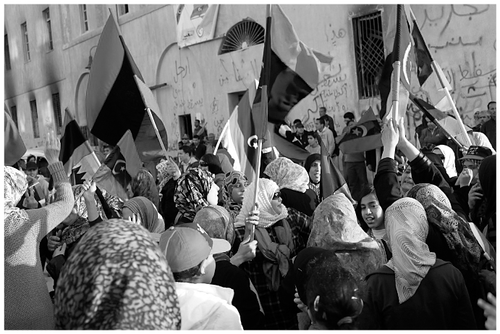
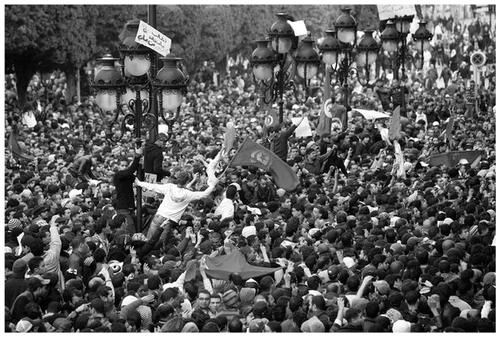
In sum, the master frame of reclamation resonated in Tunisia, Egypt, and Libya alike, all of which shared the presence of brutally repressive, pervasively corrupt, long-standing regimes pursuing neoliberal economic programs with extreme inequalities and deep suffering. The concept opens new avenues for research on protests in authoritarian regimes. The method of visual ethnography provides an opportunity to capture these protests when repression precludes using interviews or printed sources.
*This essay draws on Mounira M. Charrad, Amina Zarrugh & Hyun Jeong Ha, “The Reclamation Master Frame: A Visual Study of the Arab Uprisings.” Research in Social Movements, Conflicts & Change. Vol 44, 2021.
Mounira M. Charrad is an Associate Professor in the Department of Sociology at the University of Texas in Austin. Charrad studies state, social movements and gender.
Amina Zarrugh is an Assistant Professor in the Department of Sociology at Texas Christian University. Zarrugh studies politics and forced disappearance, and race and ethnicity.
Hyun Jeong Ha is an Assistant Professor in the Department of Sociology at Duke Kunshan University, China. Ha studies sectarianism, religion and the experiences of minorities.
